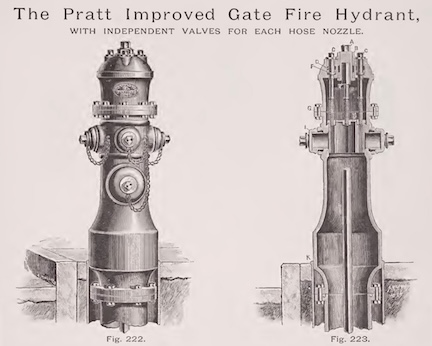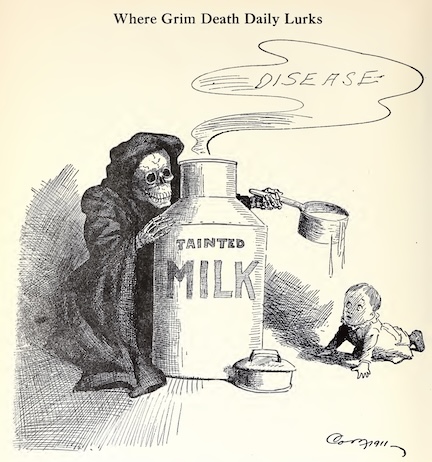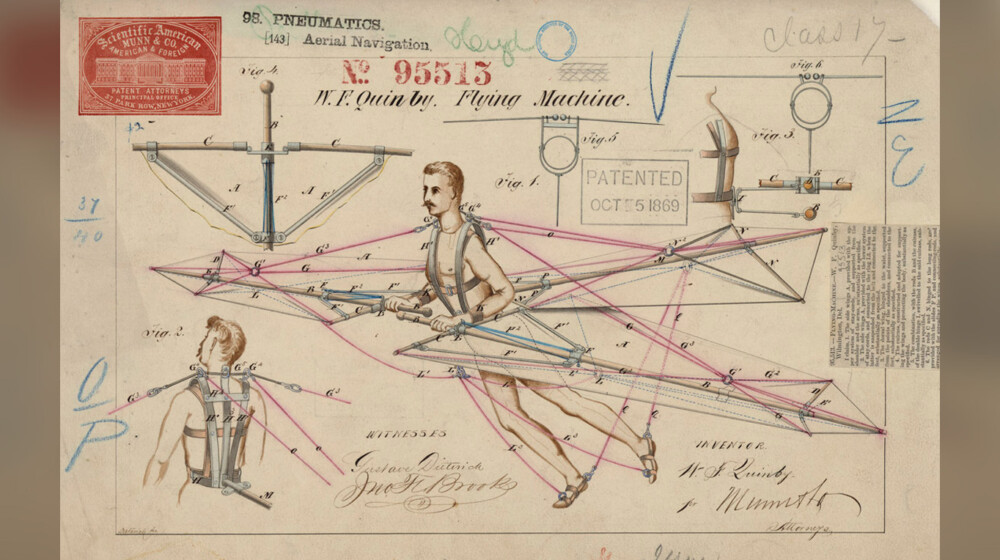tech·nol·o·gy : the use of knowledge to invent new devices or tools to make people’s lives easier;
a scientific or industrial process, invention, method, or the like.
Turn-of-the-Century Tech
Posted June 1, 2025
Written by Heather Roberts, Research Historian
Did you know…
Some people who see Rosson House think of it, and of the time period when it was built, as not very technologically advanced. But that couldn’t be further from the truth! While it’s true that the buildings at The Square were constructed before the invention of computers, the internet, smart phones, and social media, the late 19th and early 20th centuries were full of amazing technological innovations that rapidly and profoundly changed life as they knew it – and some are still influencing our lives today. How? We’re glad you asked.

Fire hydrant from the Western Valve Co. catalog, 1894.
Two of the most impactful technological innovations of the time were the development of electricity, and the establishment and improvement of water and sewer systems. The dawn of electricity may have started with a light bulb and the electrical grid, but today it not only lights our businesses and homes, it practically runs them. (Count the number of items in your home that use electricity – it’s a lot!) Effective water and sewer systems gave us the water resources to fight fires – so essential in the American West even then, as Prescott, Tombstone, and Bisbee, Arizona, all lost large portions of their business districts at the turn-of-the-century because they didn’t yet have systems providing them with enough water to fight rapidly moving fires. And it also gave us indoor sinks, showers, and toilets, but more significantly, it made our drinking water more sanitary, saving millions of lives from waterborne diseases like cholera, dysentery, and typhoid.
Due to the prevalence of infectious diseases at the time, health was a big factor in many turn-of-the-century innovations. Refrigeration cut down on foodborne illnesses caused by microorganisms like e. coli, salmonella, and listeria in spoiled food. Electric refrigerators, invented in 1913, were even better at preserving food than their 19th century “ice box” counterparts. And Willis Carrier’s 1902 invention of the modern air conditioning system continues to keep people comfortable in the heat of the summer, preventing many heat-related illnesses and deaths.

Unpasteurized milk, contaminated by feces from cattle, contains microorganisms that are particularly dangerous for infants, as shown in this political cartoon by J. Campbell Cory, 1911.
Advances in late 19th century health science also yielded pasteurization – the process of killing dangerous microorganisms in certain foods – as well as vaccines for rabies, typhoid, and cholera. Developments in the early 20th century brought early antibiotics like arsphenamine and sulfa drugs, and in 1929, the ground-breaking discovery of penicillin. After pasteurization of milk was adopted in the early 1900s, infant mortality rates plummeted. In the century since the invention of antibiotics, it’s estimated that the average person’s lifespan has been increased by over 20 years. Today, the World Health Organization reports that vaccines prevent up to 5 million deaths every year by impeding the spread of diseases like influenza, tetanus, whooping cough, and measles.
The last two significant technological advancements from the turn-of-the-century we’re mentioning here made our country and the world a smaller place. While they weren’t the elaborate communication devices we know today, telephones (invented in the late 1870s) gave people the previously unimaginable ability to communicate with loved ones not only in other towns, but eventually across the country and around the world. And no conversation about tech from that era would be complete without mentioning transportation, powered by the inventions of the steam engine (1775) and the modern internal combustion engine (1864). With these, trains, automobiles, and airplanes revolutionized travel, reducing cross-country journeys from months by wagon to days by rail or car, and just hours by plane. Their invention enabled an unprecedented movement of people and goods both nationally and worldwide.
“Necessity is the mother of invention.”
– paraphrased from Plato’s Republic, circa 380 BCE
This is by no means an exhaustive list. There are many other noteworthy inventions from the turn of the 20th century – x-rays, sewing machines, typewriters, and anesthesia, for example. In essence, people from the Gilded Age were all about innovation and discovery, creating things that made life easier, better, or both. We’ll be sharing a few articles over the next year here on our blog that highlight specific turn-of-the-century inventions – the good, the bad, and the weird. Not all of them caught on, but each of them show just how high-tech that time period was!
-
Was Rosson House really high-tech?
Absolutely! When it was constructed in 1895, Rosson House had electrical lights and an electric doorbell, a telephone, an indoor toilet, and hot and cold running water. The house itself was built with materials brought to Phoenix from other parts of the country via the railroad. The train station and Phoenix’s two ice factories were just blocks away from the home. In 1893, the Goldberg Brothers’ store (owned by then-future owner of Rosson House, Aaron Goldberg) boasted of four large electric fans to cool their customers while they shopped. The Higley family had two cars (a 1908 Mitchell, and a 1906 Kissel Kar) when they lived at Rosson House, not long after the first automobiles arrived in Phoenix in 1900.

A photo of the City Court House from the 1895 Phoenix City Directory, showing telephone poles and the trolley, which ran on electricity.
Pasteurized dairy foods were available in Phoenix as early as 1902 from the Maricopa Creamery Co., if not before. An ad in the Phoenix Herald newspaper (April 19, 1879) reported that Dr. Rosson had vaccines available at his office in the Phoenix Hotel. (Note: This was likely for smallpox, as a rudimentary vaccine for the disease had been invented in 1796. Then-General George Washington mandated smallpox inoculations for his soldiers during the Revolutionary War.) By 1890, people from Arizona were traveling by train to the Pasteur Institute in New York City to be vaccinated against rabies after being bitten by infected animals, saving themselves from almost certain death. (Note – Both the pasteurization process and the rabies vaccine were developed by Louis Pasteur.)
Important Note:
 Though air conditioning has helped reduce the amount of heat-related illnesses and deaths, they are still a dangerous reality to us here in Arizona, particularly among vulnerable populations. In 2022, there were 425 heat-related deaths in Maricopa County, and our state is consistently at the top of the list for heat-related deaths each year. To assist vulnerable populations during the hottest months, Maricopa County has established a Heat Relief Network – a network of partners providing water, cooling, and donation sites throughout the Valley. Our organization is proud to participate as a Hydration Station, providing anyone who needs it bottled water, free of charge, from May through October every year.
Though air conditioning has helped reduce the amount of heat-related illnesses and deaths, they are still a dangerous reality to us here in Arizona, particularly among vulnerable populations. In 2022, there were 425 heat-related deaths in Maricopa County, and our state is consistently at the top of the list for heat-related deaths each year. To assist vulnerable populations during the hottest months, Maricopa County has established a Heat Relief Network – a network of partners providing water, cooling, and donation sites throughout the Valley. Our organization is proud to participate as a Hydration Station, providing anyone who needs it bottled water, free of charge, from May through October every year.
-
Reference List:
Atterbury, Paul. “BBC – History – Victorian Technology.” Www.bbc.co.uk, 17 Feb. 2011, http://www.bbc.co.uk/history/british/victorians/victorian_technology_01.shtml.
Bellis, Mary. “Top Inventions of the 19th Century.” ThoughtCo, 11 May 2025, www.thoughtco.com/inventions-nineteenth-century-4144740.
Bisbee Mining & Historical Museum. “Story of the 1908 Fire.” Bisbee Mining & Historical Museum, 2021, www.bisbeemuseum.org/postcard_archive/1977-25-25b-pc/
“Can It: The History of Food Storage.” The Square PHX, Apr. 2022, www.thesquarephx.org/news/can-it/.
Centers for Disease Control and Prevention. “Achievements in Public Health, 1900-1999: Control of Infectious Diseases.” Www.cdc.gov, 30 July 1999, www.cdc.gov/mmwr/preview/mmwrhtml/mm4829a1.htm#fig1.
Centers for Disease Control and Prevention. “QuickStats: Age-Adjusted Rates of Death Involving Exposure to Excessive Heat among States with the Highest Numbers of Deaths.” MMWR. Morbidity and Mortality Weekly Report, 1 Sept. 2023, www.dx.doi.org/10.15585/mmwr.mm7235a7.
City of Prescott. “Prescott History.” Prescott, www.prescott.com/history.
Courtney, Brad. “Prelude to Prescott’s Great Fire of 1900.” Sharlot Hall Museum, 17 June 2017, www.archives.sharlothallmuseum.org/articles/days-past-articles/1/prelude-to-prescotts-great-fire-of-1900.
Currier, Russel W., and John A. Widness. “A Brief History of Milk Hygiene and Its Impact on Infant Mortality from 1875 to 1925 and Implications for Today: A Review.” Journal of Food Protection, vol. 81, no. 10, 20 Sept. 2018, pp. 1713–1722, www.sciencedirect.com/science/article/pii/S0362028X22087610.
“Down the Drain: The History of Water & Sewer Systems.” The Square PHX, May 2021, www.thesquarephx.org/news/down-the-drain/.
“Antibiotics: Past, Present and Future.” Current Opinion in Microbiology, vol. 51, no. 1, Oct. 2019, pp. 72–80, http://www.sciencedirect.com/science/article/pii/S1369527419300190.
Lansberg, Erica. “Hedy Lamarr’s WWII Invention Helped Shape Modern Tech.” The National WWII Museum | New Orleans, 23 Apr. 2025, www.nationalww2museum.org/war/articles/hedy-lamarrs-wwii-invention-helped-shape-modern-tech.
Leiker, Karl K. “Heat Waves and Heat Mortality in the United States during the Twentieth Century (2002 – 15BioAero_15bioaero).” American Meteorological Society, 15th Conf. on Biometeorology/Aerobiology and 16th International Congress of Biometeorology, 30 Oct. 2002, www.ams.confex.com/ams/15BioAero/techprogram/paper_49534.htm.
Lester, Paul. “History of Air Conditioning.” US Dept of Energy, 20 July 2015, www.energy.gov/articles/history-air-conditioning.
Morais, Betsy. “Ada Lovelace, the First Tech Visionary.” The New Yorker, 15 Oct. 2013, www.newyorker.com/tech/annals-of-technology/ada-lovelace-the-first-tech-visionary.
Science History Institute Museum & Library. “Gerhard Domagk.” Science History Institute, www.sciencehistory.org/education/scientific-biographies/gerhard-domagk/.
Snyder, Margaret. “Sour Milk: Preventing Infant Mortality with Public Health.” REsource, Rockefeller Archive Center, 6 May 2020, www.resource.rockarch.org/story/sour-milk-preventing-infant-mortality-with-public-health-rockefeller-institute-food-safety-study/.
Taylor, Don. “History of Tombstone.” Discover Tombstone Arizona, www.discovertombstone.com/history/.
“Telephones at the Turn-of-The-Century.” The Square PHX, Apr. 2021, www.thesquarephx.org/news/telephones/.
Thompson, Mary V. “Smallpox.” The George Washington Presidential Library at Mount Vernon, www.mountvernon.org/library/digitalhistory/digital-encyclopedia/article/smallpox.
University of Houston. “Accelerating Transportation.” Digital History, 2021, www.digitalhistory.uh.edu/disp_textbook.cfm?smtid=2&psid=3509.
US Census Bureau. “History and the Census: The Transcontinental Railroad.” Census.gov, 1 May 2023, www.census.gov/about/history/stories/monthly/2023/may-2023.html.
World Health Organization. “Vaccines and Immunization.” World Health Organization, 2024, www.who.int/health-topics/vaccines-and-immunization#tab=tab_1.
Archive
-
2025
-
November (1)
-
October (1)
-
September (1)
-
August (1)
-
June (1)
-
May (2)
-
April (1)
-
January (1)
-
-
2024
-
December (1)
-
November (1)
-
October (1)
-
September (1)
-
August (1)
-
July (1)
-
June (1)
-
May (1)
-
April (1)
-
March (1)
-
February (1)
-
January (1)
-
-
2023
-
December (1)
-
November (1)
-
October (1)
-
September (1)
-
August (1)
-
July (1)
-
June (1)
-
May (1)
-
April (1)
-
March (1)
-
February (1)
-
January (1)
-
-
2022
-
December (1)
-
November (1)
-
October (1)
-
September (1)
-
August (1)
-
July (1)
-
June (1)
-
May (1)
-
April (1)
-
-
2021
-
December (1)
-
November (1)
-
October (1)
-
September (1)
-
August (1)
-
July (1)
-
June (1)
-
May (1)
-
April (1)
-
March (1)
-
February (1)
-
January (1)
-
-
2020
-
December (1)
-
November (1)
-
October (1)
-
September (1)
-
August (1)
-
July (1)
-
June (1)
-
May (1)
-
April (1)
-
March (1)
-
February (1)
-
January (1)
-
-
2019
-
December (1)
-
November (1)
-
October (1)
-
September (1)
-
August (1)
-
July (1)
-
June (1)
-
May (1)
-
April (1)
-
March (1)
-
February (1)
-
January (1)
-
-
2018
-
December (1)
-
November (1)
-
October (1)
-
September (1)
-
August (1)
-
July (1)
-
May (1)
-
April (1)
-
March (1)
-
February (1)
-
January (1)
-
-
2017
-
December (1)
-
November (1)
-
October (1)
-
September (1)
-
August (1)
-
July (1)
-
June (1)
-
May (1)
-
April (1)
-
March (1)
-
February (1)
-
-
2016
-
2015
-
2014
-
July (1)
-
